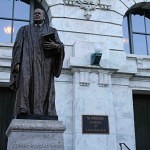Directions: Below are three examples of controversial education issues in New Orleans. Each issue includes two statements that describe the same scenario, albeit in slightly different ways. Read each statement and then answer the question that follows.
Issue 1: Standardized Testing
Statement A: “More than a third of the city’s schools were flagged by the state between 2010 and 2012 for cases of plagiarism, suspicious levels of erasures, and similar indicators.”
Statement B: “130 tests out of several thousand administered between 2010 and 2012 were voided due to testing irregularities.”
Question: Which statement leaves readers with the impression that there are widespread testing irregularities in New Orleans schools?
Issue 2: Civil Rights Complaints
Statement A: “This past spring, 30 students and families filed a civil rights complaint against Collegiate Academies, a group of three high schools that then had the highest suspension rates in the city. The complaint alleged that harsh discipline was being used to target kids with disabilities.”
Statement B: “This past spring, a group of students and families filed a civil rights complaint against Collegiate Academies alleging that harsh discipline was being used to target kids with disabilities. However in May, the Louisiana Department of Education announced it was suspending its investigation into the matter because the complaint provided insufficient evidence to substantiate the charges.”
Question: Which statement leaves readers with the impression that the accusations made in the civil rights complaint are valid?
Issue 3: Neighborhood Schools
Statement A: “The Neighborhood School Is A Thing Of The Past: One in four New Orleans students attended a school more than five miles from home during the 2011-12 school year, according to data compiled by the Education Research Alliance. The Orleans Parish School Board plotted how far students travelled to get to their schools in 2013. Below, the paths travelled by students of [two] selected charter schools:”

Statement B: “Before the storm, 35 percent of students lived within half a mile of their school. In 2011-12, the percentage of students living within that radius had dropped to 10 percent. But the research also shows that school choice was pervasive even before the 2005 storm. In 2004, over half the city’s students did not go to their neighborhood school. ‘I don’t think it’s a simple story,’ said professor Doug Harris, head of the university’s new Education Research Alliance for New Orleans.”1

Question: Which statement leaves readers with the impression that most students attended their neighborhood school prior to Katrina?
I’m going to guess that you answered “Statement A” for each of the questions above.
In the standardized testing example, the way Statement A is phrased makes it seem like there was widespread cheating going on in New Orleans schools, when in fact, only a small fraction of tests were voided during that two-year period. In regard to the civil rights complaint, Statement A again sounds more damning without the additional context that LDOE suspended its investigation due to insufficient evidence. And in the last example, Statement A makes it seem as if most students attended their neighborhood school before Katrina, when in reality, that wasn’t the case.
This exercise shows how phrasing and the selective omission of pertinent facts can radically change a reader’s perception of an issue. Interestingly enough, Statement A in each of the examples above were taken from Anya Kamenetz‘s piece, “The End Of Neighborhood Schools,” which was published on NPR’s website this morning.
Just something to keep in mind next time you’re reading a report on education in New Orleans!
- Quotes and graphic taken from “Traveling farther to school, but choice was in New Orleans before” by Danielle Dreilinger. ↩


15 Comments
Leave a Reply